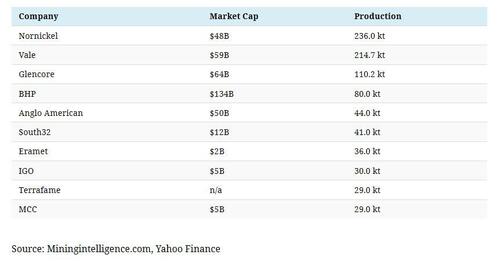The World’s Largest Nickel Mining Companies
By Niccolo Conte of VisualCapitalist.com
The World’s Top 10 Nickel Mining Companies
As the world transitions towards electric vehicles and cleaner energy sources, nickel has emerged as an essential metal for this green revolution.
Needed for the manufacturing of electric vehicles, wind turbines, and nuclear power plants, nickel is also primarily used to make stainless steel alloys more resistant to corrosion and extreme temperatures.
Using data from Mining Intelligence, this graphic shows the top 10 companies by nickel production along with their market cap.
The Biggest Nickel Miners by Production in 2020
Nickel has long been an important mineral for batteries, plating, and steelmaking, but it was only recently added to the USGS’s proposed critical minerals list.
As countries and industries realize the importance of nickel for the development of sustainable technologies, nickel mining companies will be at the forefront of supplying the world with the nickel it needs.
The 850 kt of nickel mined by the top 10 nickel mining companies is worth around $17.3B, with both production and price expected to grow alongside nickel demand.
Nickel and palladium miner and smelter Nornickel leads the list with 236 kt of nickel produced in 2020, the majority coming from its Norilsk division of flagship assets in Russia.
With 46% of Nornickel’s energy mix sourced from renewable power, the company is pushing the development of carbon neutral nickel, starting with reducing carbon dioxide emissions by 60,000-70,000 tons in 2022.
Vale follows closely behind in production and in its carbon footprint goals. The Brazil-based company’s Long Harbour processing plant in Newfoundland and Labrador produces nickel with a carbon footprint about a third of the industry average–4.4 tonnes of CO2 equivalent per tonne of nickel compared to Nickel Institute’s average of 13 tonnes of CO2 equivalent.
With the top two companies producing more than half of the nickel produced by the top 10 miners, their efforts in decarbonization will pave the way for the nickel mining industry.
The Need for Nickel in the Energy Transition
Alongside the decarbonization of the nickel mining process, nickel itself powers many of the technologies crucial to the energy transition. Vehicle electrification is highly dependent on nickel, with a single electric car requiring more than 87 pounds of nickel, making up almost 1/5th of all the metals required.
With a history of being used in nickel cadmium and nickel metal hydride batteries, nickel is now being increasingly used in lithium-ion batteries for its greater energy density and lower cost compared to cobalt. Alongside the increase in usage, not all nickel is suitable for lithium-ion battery production, as batteries require the rarer form of the metal’s deposits known as nickel sulphides.
The more common form of the metal, nickel laterites, are still useful in forming the alloys that make up the frames and various gears of wind turbines.
Nickel is also essential to nuclear power plants, making up nearly a quarter of the metals needed per megawatt generated.
The Future of Nickel Mining and Processing
With nickel in such high demand for batteries and cleaner energy infrastructure, it’s no wonder that global nickel demand is expected to outweigh supply by 2024. The scarcity of high grade nickel sulphide deposits and the carbon intensity to mine them has also incentivized the exploration of new methods of harvesting the metal.
Agro-mining uses plants known as hyperaccumulators to absorb metals found in the soil through their roots, resulting in their leaves containing up to 4% nickel in dry weight. These plants are then harvested and incinerated, with their ash processed to recover the nickel “bio-ore”.
Along with providing us with metals like nickel, lead, and cobalt through a less energy intensive process, agro-mining also helps decontaminate polluted soil.
While new processes like agro-mining won’t replace traditional mining, they’ll be a helpful step forward in closing the future nickel supply gap while helping reduce the carbon footprint of the nickel processing industry.
Tyler Durden
Tue, 03/08/2022 – 02:00
Zero Hedge’s mission is to widen the scope of financial, economic and political information available to the professional investing public, to skeptically examine and, where necessary, attack the flaccid institution that financial journalism has become, to liberate oppressed knowledge, to provide analysis uninhibited by political constraint and to facilitate information’s unending quest for freedom. Visit https://www.zerohedge.com

